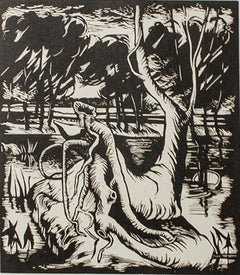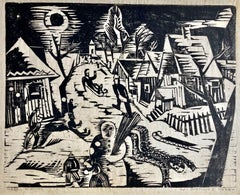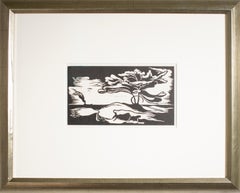Harold Wescott Art
b. 1911
Harold Wescott was a prominent Milwaukee printmaker with an association to the WPA. Established in 1935, Wisconsin Printmakers published its first of three annual calendars the following year, in a limited edition of about 2500 copies. Harold Westcott was included in the 1938 calendar, the last issued, with contributions from 38 Wisconsin artists whose work in oil, watercolor and the crafts are known locally and outside the state. He was also a painter and teacher at the State Teachers College, Wisconsin.
to
1
Overall Width
to
Overall Height
to
1
1
1
1
1
1
1
1
9,989
2,754
1,379
1,375
1
Artist: Harold Wescott
"Flood Waters, " Landscape Wood Engraving by Harold Wescott
By Harold Wescott
Located in Milwaukee, WI
"Flood Waters" is an original wood engraving by Harold Wescott, It features a tree in the center, with its roots wrapping languidly over a form. High waters rise up from the back. Un...
Category
1930s American Modern Harold Wescott Art
Materials
Woodcut
Related Items
Elwood W. Bartlett, Wisconsin Farm, about 1945, mid-century wood engraving
Located in New York, NY
Elwood Warren Bartlett is a Wisconsin native who also worked in Indiana.
Largely self taught as a printmaker, Bartlett worked in a style that once identified as his, immediately t...
Category
1940s American Modern Harold Wescott Art
Materials
Woodcut
Werner Drewes, Winter, 1933, modernist woodcut
By Werner Drewes
Located in New York, NY
A modernist fantasy winter scene created by Werner Drewes, this print brings key aspects of the period together. His cubist-inspired woodcut technique is utilized here to bring the s...
Category
1930s American Modern Harold Wescott Art
Materials
Woodcut
'Taos Placita' — American Southwest Regionalist Masterwork
By Gustave Baumann
Located in Myrtle Beach, SC
Gustave Baumann, 'Taos Placita', color woodcut, 1947, edition 125. Baumann 132. Signed, titled, and numbered '20-125' in pencil; with the artist’s Hand-in-Heart chop. A superb, richly-inked impression, with fresh colors, on fibrous oatmeal wove paper; the full sheet with margins (2 to 3 1/8 inches); slight rippling at the left sheet edge, in excellent condition. Matted to museum standards, unframed.
Image size 9 5/8 x 11 1/4 inches (244 x 286 mm); sheet size 13 1/4 x 17 inches (337 x 432 mm).
Collections: Harwood Museum of Art, New Mexico Museum of Art, Phoenix Art Museum, Scottsdale Art Museum, Wichita Art Museum.
ABOUT THE ARTIST
Gustave Baumann (1881-1971) was a renowned printmaker and a leading figure of the American color woodcut revival whose exquisite craftsmanship and vibrant imagery captured the essence of the Southwest.
"A brilliant printmaker, Baumann brought to the medium a full mastery of the craft of woodworking that he acquired from his father, a German cabinetmaker. This craftsmanship was coupled with a strong artistic training that resulted in the handsome objects we see in the exhibition today. After discovering New Mexico in 1918, Baumann began to explore in his woodblock prints of this period the light. color, and architectural forms of that landscape. His prints of this period are among the most beautiful and poetic images of the American West."
—Lewis I. Sharp, Director, Denver Art Museum
Baumann, the son of a craftsman, immigrated to the United States from Germany with his family when he was ten, settling in Chicago. From 1897 to 1904, he studied in the evenings at the Art Institute of Chicago, working in a commercial printmaking shop during the day. In 1905, he returned to Germany to attend the Kunstwerbe Schule in Munich, where he decided on a career in printmaking. He returned to Chicago in 1906 and worked for a few years as a graphic designer of labels.
Baumann made his first prints in 1909 and exhibited them at the Art Institute of Chicago the following year. In 1910, he moved to the artists’ colony in Nashville, Indiana, where he explored the creative and commercial possibilities of a career as a printmaker. In 1915, he exhibited his color woodcuts at the Panama-Pacific International Exposition in San Francisco, winning the gold medal.
Among Baumann’s ongoing commercial activities was his work for the Packard Motor Car Company from 1914 to 1920 where he produced designs, illustrations, and color woodcuts until 1923.
In 1919, Baumann’s printmaking work dominated the important exhibition of American color woodcuts at the Detroit Institute of Arts. Twenty-six of his prints were included, far more than the works of any other artist. A set of his blocks, a preparatory drawing, and seven progressive proofs complemented the exhibition. That same year, Baumann worked in New York and, over the summer, in Provincetown, Massachusetts. His airy images of Cape Cod employed soft, pastel colors and occasionally showed the influence of the white-line woodcut technique.
Many of his Chicago artist friends had traveled to the southwest, and Baumann became intrigued by their paintings, souvenirs, and stories of an exotic place named Taos, New Mexico. In the summer of 1918, he spent the summer in Taos sketching and painting before visiting Santa Fe. Paul Walter, the director of the Museum of New Mexico, offered him a studio in the museum's basement. Inspired by the rugged beauty of the Southwest—the vibrant colors and dramatic landscapes of the region became a central theme in his work, influencing his artistic style and subject matter for the remainder of his career. Later in the decade, he traveled to the West Coast and made prints of California landscape.
Baumann's prints became synonymous with the Southwest, capturing the spirit of its place in America's identity with a unique sense of authenticity and reverence. His iconic images of desert vistas, pueblo villages, and indigenous cultures served as visual tributes to the region's rich cultural heritage, earning him a dedicated following among collectors and curators alike.
A true craftsman and artist, Baumann completed every step of the printmaking process himself, cutting each block, mixing the inks, and printing every impression on the handmade paper he selected. His dedication to true craftsmanship and his commitment to preserving the integrity of his artistic vision earned him widespread acclaim and recognition within the art world. About the vibrant colors he produced, Baumann stated, “A knowledge of color needs to be acquired since they don’t all behave the same way when ground or mixed...careful chemistry goes into the making of colors, with meticulous testing for permanence. While complicated formulae evolve new colors, those derived from Earth and metal bases are still the most reliable.”
In the 1930s, Baumann became interested in puppet theater. He designed and carved his own marionettes and established a little traveling company. From 1943 to 1945, the artist carved an altarpiece for the Episcopal Church of the Holy Faith in Santa Fe. In 1952, a retrospective exhibition of his prints was mounted at the New Mexico Museum of Fine Arts. Throughout his prolific career, Baumann executed nearly four hundred color woodcuts.
Baumann’s woodcuts...
Category
1940s American Modern Harold Wescott Art
Materials
Woodcut
$19,000
H 9.63 in W 11.25 in
Tranquil Harbor (Gloucester, Massachusetts) — 1950s Cape Ann Regionalism
By Lawrence Wilbur
Located in Myrtle Beach, SC
Lawrence Nelson Wilbur (1897-1988), 'Tranquil Harbor' (Gloucester, Massachusetts), wood engraving, edition 55, 1958. Signed in pencil, and signe...
Category
1950s American Modern Harold Wescott Art
Materials
Woodcut
$700
H 8.38 in W 10.07 in
Stevan Dohanos, Backyard
By Stevan Dohanos
Located in New York, NY
Stevan Dohanos was an accomplished draftsman who work was widely known through the Saturday Evening Post. This print 'Backyard,' however, leaves aside the illustrative magazine work ...
Category
1930s American Modern Harold Wescott Art
Materials
Woodcut
THE THAW
By William Seltzer Rice
Located in Santa Monica, CA
WILLIAM SELTZER RICE (1873 - 1963)
THE THAW c 1915-20
Color woodcut, signed and titled in pencil. Image 8 7/8 x 12 inches, sheet 10 3/4 x 14 3/8 inches. On textured fibrous paper. V...
Category
1910s American Modern Harold Wescott Art
Materials
Color, Woodcut
THE SUNFLOWER
Located in Santa Monica, CA
ANDERS ALDRIN (Swedish /American 1889 – 1970)
THE SUNFLOWER ca. 1935 (Newark Museum 9)
Color woodcut, edition c. 150. Signed, unnumbered, but dedicat...
Category
1930s American Modern Harold Wescott Art
Materials
Woodcut
'Sundown, Stonington, Maine' — Artist-printed Exhibition Proof
By Lawrence Wilbur
Located in Myrtle Beach, SC
Lawrence Nelson Wilbur (1897-1988), 'Sundown, Stonington, Maine', wood engraving, artist's proof, edition not stated but small, 1969. Signed and titled in pencil. Signed in the block...
Category
1940s American Modern Harold Wescott Art
Materials
Woodcut
$550
H 5.13 in W 6.07 in
Modern American Industrial Landscape
Located in Buffalo, NY
An original woodblock print dated 1965, titled "Our Town" but signed illegibly.
Category
1960s American Modern Harold Wescott Art
Materials
Paper, Woodcut
Chrysler Building (Chrysler Building in Construction)
By Howard Norton Cook
Located in New York, NY
Howard Cook (1901-1980), Chrysler Building (Chrysler Building in Construction) – –1930, Wood Engraving.
Duffy 122. Edition 75, only 50 printed. 19...
Category
1930s American Modern Harold Wescott Art
Materials
Woodcut
A Handsome Woodcut on Paper of the Univ. of Chicago Chapel by Siegfried Weng
Located in Chicago, IL
A handsome woodcut on paper of the University of Chicago Chapel by artist Siegfried Weng. A perfect gift for your U of C grad! Arwork size:
9 3/4" x 7 1/2". Archivally matted to...
Category
1920s American Modern Harold Wescott Art
Materials
Paper, Woodcut
Henry R. Diamond, Whaler
By Henry R. Diamond
Located in New York, NY
Really a wood engraving rather than a woodcut, Henry R. Diamond's Whaler is majestic. It is signed and titled in pencil.
Category
Early 20th Century American Modern Harold Wescott Art
Materials
Woodcut
Previously Available Items
'Lake Shore' original linoleum cut print by Harold Wescott, tree boat wave
By Harold Wescott
Located in Milwaukee, WI
In this linoleum print, Harold Wescott captures a moody view of the shore of Lake Michigan. The contrast between the black ink and white paper create the effect of an oncoming storm ...
Category
1930s American Modern Harold Wescott Art
Materials
Engraving, Linocut
Harold Wescott art for sale on 1stDibs.
Find a wide variety of authentic Harold Wescott art available for sale on 1stDibs. You can also browse by medium to find art by Harold Wescott in woodcut print and more. Much of the original work by this artist or collective was created during the 1930s and is mostly associated with the modern style. Not every interior allows for large Harold Wescott art, so small editions measuring 16 inches across are available. Customers who are interested in this artist might also find the work of Armin Landeck, John Taylor Arms, and Emil Ganso. Harold Wescott art prices can differ depending upon medium, time period and other attributes. On 1stDibs, the price for these items starts at $1,285 and tops out at $1,285, while the average work can sell for $1,285.



